Moscow launches largest drone assault of the war as Putin prepares to speak with Trump, while Europe rallies around Ukraine and Romania rejects the far-right
Summary of the Day – May 18, 2025
As dawn broke over Ukraine on May 18, the debris of Moscow’s largest single drone attack littered the landscape—273 Shaheds and decoys that announced Russia’s intentions more clearly than any diplomatic communiqué. Coming mere hours before Putin’s scheduled call with Trump, the assault killed at least two civilians and injured 23 more while demonstrating the Kremlin’s contempt for Western peace efforts. Yet the day also brought signs of resilience: Romania rejected far-right candidate George Simion’s anti-Ukrainian platform, electing pro-EU Nicusor Dan as president, while European leaders coordinated their approach ahead of the Trump-Putin call. Putin himself revealed his hand through leaked documentary footage, declaring Russia has “enough forces and means” to achieve its war aims without concessions, even as his intelligence services prepared an intercontinental ballistic missile “training” launch designed to intimidate Western capitals.
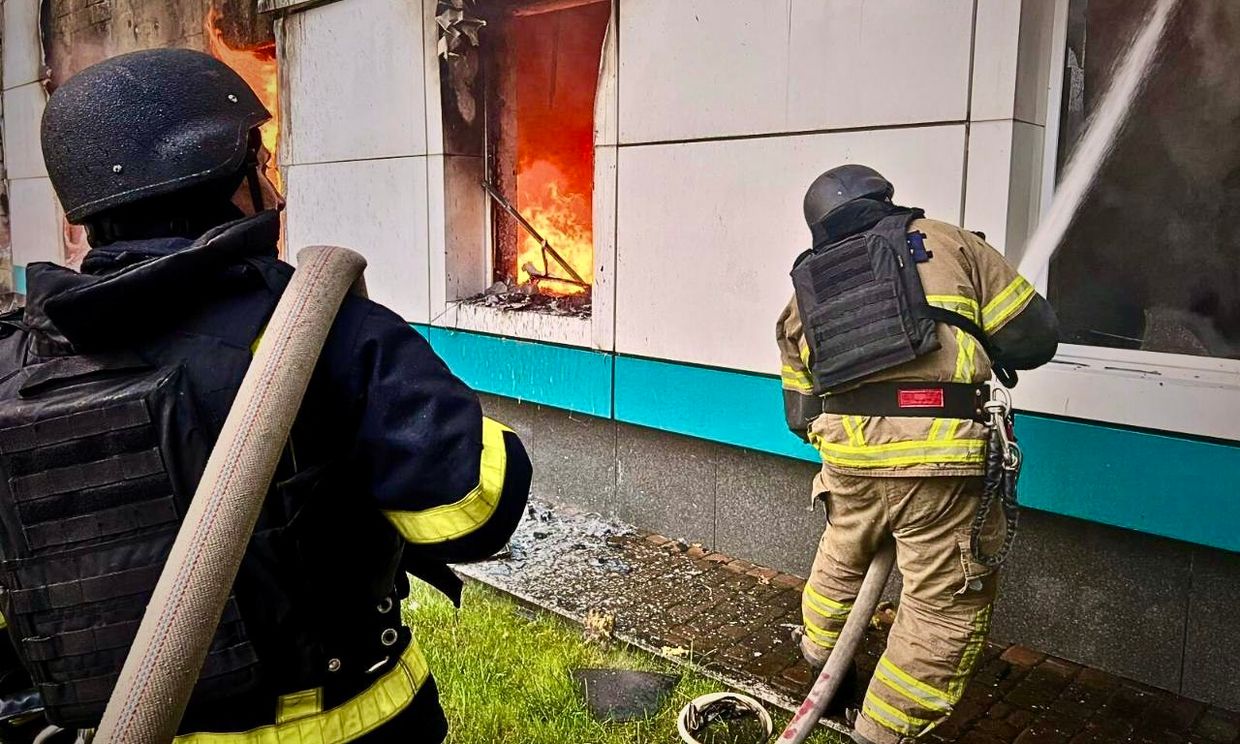
First responders are working at the site of a Russian drone attack in Kyiv Oblast, Ukraine. (State Emergency Service / Telegram)
Death from Above: Russia’s Record-Breaking Drone Assault
The numbers told their own brutal story: 273 drones launched in a single night—the largest aerial assault of Russia’s war against Ukraine. Launched from Bryansk, Kursk, and Oryol cities, as well as Millerovo in Rostov Oblast and Primorsko-Akhtarsk in Krasnodar Krai, the swarm represented a coordinated attack across multiple directions designed to overwhelm Ukrainian defenses.
Ukrainian forces managed to destroy 88 drones while 128 others—likely decoys packed with jamming equipment rather than warheads—vanished from radar screens. Yet enough penetrated the defenses to exact their intended toll: in Kyiv Oblast, one civilian died and three were wounded when drones struck residential areas, while Donetsk Oblast lost another life in Yablunivka.
The scale dwarfed the previous record of 267 drones launched on February 23, marking a grim milestone in Russia’s campaign of technological terror. The attack targeted multiple oblasts simultaneously—Kyiv, Dnipropetrovsk, Donetsk, Kherson, and Zaporizhzhia—creating a coordinated assault that spread Ukrainian defenses thin across hundreds of kilometers.
Most revealing was the timing: the barrage came exactly one day before Putin’s planned conversation with Trump, as if Moscow wanted to demonstrate its capabilities before any discussion of ceasefires or concessions. Russian milbloggers claimed the strike’s effectiveness came from deploying “Geran-3” drones equipped with turbo jets and 300-kilogram warheads—a technological evolution that made each platform deadlier than its predecessors.
Cultural Resilience: Book Arsenal Returns
Amid the violence and diplomatic tensions, Ukraine announced that the 13th Book Arsenal festival would take place in Kyiv from May 29 to June 1. The cultural event, curated around the theme “Everything is Translation,” represented the nation’s determination to maintain intellectual and artistic life despite the war’s pressures.
The festival’s continuation demonstrated Ukraine’s commitment to preserving its cultural identity even as Russian forces targeted civilian infrastructure and cultural sites. In a war partly about narratives and identity, such events carried significance beyond their immediate cultural value—they represented defiance against attempts to erase Ukrainian civilization.
Regional Devastation: The Human Cost Across Oblasts
The drone attack’s impact spread far beyond raw numbers. In Kyiv Oblast, Governor Mykola Kalashnyk reported that a 28-year-old woman died from her injuries while a 59-year-old man, a 61-year-old woman, and a 4-year-old child were hospitalized. Civilian targets included houses and a multi-story residential building—deliberate strikes against non-military infrastructure.
Donetsk Oblast bore additional punishment beyond the overnight drone assault. Governor Vadym Filashkin reported that Russian forces conducted 343 separate strikes on 11 settlements, killing a 27-year-old woman in Yablunivka with an FPV drone and injuring eight others across the region. The systematic nature of these attacks—targeting everything from civilian vehicles to residential buildings—illustrated Russia’s strategy of making life unbearable for those remaining in government-controlled areas.
In Kherson Oblast, eight people were wounded as Russian forces damaged an apartment building and houses. Governor Oleksandr Prokudin’s matter-of-fact reporting captured the routine horror: another day, more civilians injured, more homes destroyed in areas within artillery range of Russian positions across the Dnipro River.
Dnipropetrovsk Oblast saw two women, aged 48 and 52, injured in Russian strikes, while Zaporizhzhia Oblast endured two injuries alongside systematic infrastructure damage from the 343 documented attacks.
Putin’s Documentary Gambit: “Enough Forces and Means”
As debris was cleared from Ukrainian cities, new footage emerged that laid bare Putin’s true intentions. Previously unreleased clips from a documentary filmed on March 27 showed the Russian president declaring that Moscow possessed “enough forces and means to bring what we started in 2022 to a logical conclusion with the result Russia needs.”
The footage, originally shot for “Russia. Kremlin. Putin. 25 Years” but only released on May 18, revealed a leader supremely confident in his war machine’s capacity to achieve total victory. Putin spoke of eliminating the “root causes” of the conflict and creating “conditions for long-term sustainable peace and the security of the Russian state”—euphemisms for Ukrainian capitulation.
The timing of this revelation was no accident. With Trump preparing to call on May 19, Putin wanted the American president to understand that Russia was negotiating from a position of strength, not desperation. The message was unmistakable: Moscow would accept nothing less than complete victory, regardless of Western pressure or Ukrainian resistance.
In the documentary clips, Putin specifically mentioned securing Russian-speaking populations in territories Russia claims as its own—a reference to Crimea and four partly occupied Ukrainian oblasts. This language reinforced demands made during the failed Istanbul talks just two days earlier, where Russian negotiators had insisted on Ukrainian withdrawal from all annexed territories.
Nuclear Intimidation: The Yars Missile Threat
Putin’s intimidation campaign extended beyond conventional drones. Ukrainian military intelligence reported that Russia planned a “training” launch of an RS-24 Yars intercontinental ballistic missile overnight on May 19—precisely as Trump and Putin would be conducting their phone conversation.
The Yars, capable of carrying nuclear warheads equivalent to one million tons of TNT across 11,000 kilometers, would be fired near Svobodny village in Sverdlovsk Oblast. Though equipped with a “training” warhead, the launch served an obvious purpose: reminding the West of Russia’s nuclear arsenal as diplomatic discussions intensified.
This escalatory gesture echoed Russia’s use of the Oreshnik intermediate-range ballistic missile against Dnipro in November 2024, which had followed the lifting of Western restrictions on long-range Ukrainian strikes. Both incidents demonstrated Putin’s willingness to brandish nuclear weapons as diplomatic tools, raising stakes whenever Western support for Ukraine appeared to strengthen.
The planned launch represented more than technical demonstration—it was psychological warfare designed to inject nuclear anxiety into any conversation about Ukrainian sovereignty or territorial integrity. By scheduling it to coincide with the Trump call, Putin ensured that nuclear threats would lurk behind every diplomatic exchange.
European Unity: Leaders Coordinate Before Trump-Putin Call
European leaders moved quickly to present a united front before Trump’s conversation with Putin. German Chancellor Friedrich Merz announced that he, French President Emmanuel Macron, and British Prime Minister Keir Starmer would speak with Trump before his call with the Russian president.
“We have now agreed that we will talk again—the four heads of state and government and the American president in preparation for this conversation,” Merz said from the Vatican, where world leaders had gathered for Pope Leo XIV’s inaugural mass.
This coordination represented Europe’s determination to ensure that Western unity wouldn’t fracture under pressure from Putin’s maximalist demands. The leaders wanted Trump to understand that Europe remained firmly behind Ukraine’s position and wouldn’t accept any peace agreement that rewarded Russian aggression.
Finnish President Alexander Stubb, who had spoken with both Trump and Zelensky, detected growing American impatience with Russian intransigence. “You could say that Zelensky is patient and President Trump is getting impatient, but in the right direction, which is towards Russia,” Stubb told reporters in Tallinn.
The Finnish leader’s assessment suggested that Trump’s frustration might finally be turning against Moscow rather than Kyiv—a development that could strengthen Ukraine’s position if pressure for concessions shifted to the aggressor rather than the victim.
Romania Rejects Extremism: Dan Defeats Simion in Presidential Runoff
In one of the day’s most significant developments, Romanian voters decisively rejected far-right candidate George Simion, electing pro-EU Nicusor Dan as president with 53.6% of the vote. The result removed a potential threat to European unity and preserved Romania’s role as a crucial Ukrainian ally.
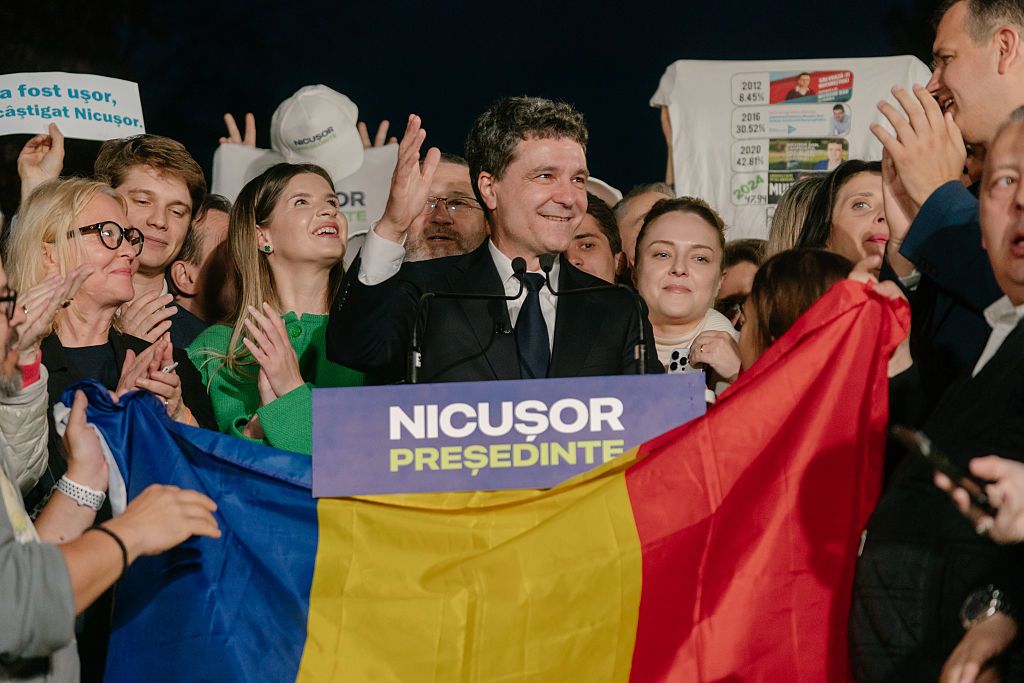
Presidential candidate Nicusor Dan greets supporters after the first exit poll results on the day of the presidential election in Bucharest, Romania. (Andrei Pungovschi/Getty Images)
Simion’s defeat marked a rejection of his anti-Ukrainian platform, which included ending military aid to Kyiv and demanding compensation for Romania’s support. His statement that “Ukraine needs us, we don’t need Ukraine” had alarmed European capitals and raised fears that Russian influence might gain a foothold in NATO’s eastern flank.
Dan’s victory preserved continuity in Romania’s support for Ukraine, including the Patriot missile system donated in 2024 and the bilateral security agreement signed with Kyiv. As mayor of Bucharest, Dan had consistently supported aid to Ukraine as “essential for the security of Romania.”
President Zelensky quickly congratulated Dan, emphasizing that “for Ukraine—as a neighbor and friend—it is important to have a reliable partner in Romania.” The election result confirmed that despite Russian disinformation campaigns and economic pressures, Eastern European publics remained committed to Ukrainian sovereignty.
The vote also vindicated Romania’s constitutional court’s decision to annul the previous election due to Russian interference, proving that defensive measures against foreign manipulation could preserve democratic integrity without compromising legitimacy.
Poland’s Democratic Test: Cyberattacks and Election Results
Poland faced its own test of democratic resilience as voters headed to polls amid unprecedented Russian interference. Prime Minister Donald Tusk reported that Russian hackers had targeted websites of his ruling coalition just days before the election, attacking the Civic Platform, Left, and Polish People’s Party platforms.
The cyberattacks formed part of a broader Russian disinformation campaign codenamed “Doppelganger,” according to Ukrainian military intelligence. Since March 2025, Russian intelligence services had been spreading false messages targeting Polish voters through fake media websites mimicking trusted Western outlets.
Exit polls suggested pro-EU Warsaw mayor Rafal Trzaskowski would face nationalist historian Karol Nawrocki in a runoff scheduled for June 1. More concerning for European unity, the far-right achieved record gains, with candidates Slawomir Mentzen and Grzegorz Braun receiving a combined 21.6% of votes—the strongest showing for extremist parties in modern Polish history.
The Polish election results highlighted growing polarization across Europe, with pro-Russian and Eurosceptic forces gaining ground even in countries directly threatened by Moscow’s aggression. The interference demonstrated Russia’s commitment to destabilizing Western democracies through hybrid warfare tactics.
Battlefield Details: Incremental Gains at Enormous Cost
Fighting across Ukraine’s extended frontline continued with characteristic intensity. Geolocated footage confirmed Russian advances south of Hrekivka and northeast of Novomykhailivka near Borova, while additional gains were reported in southwestern Yablunivka near Toretsk.
Russian forces conducted 343 strikes on 11 settlements in Zaporizhzhia Oblast alone, wounding two civilians and damaging multiple infrastructure sites. The systematic bombardment reflected Moscow’s strategy of making civilian life impossible in areas Ukraine still controlled.
Ukrainian military observers noted Russian attempts to use boats and motorcycles on pulley systems to cross the Oskil River near Dvorichna—creative tactics reflecting both resource constraints and persistent pressure to advance. Russia’s willingness to employ improvised crossing methods suggested growing desperation to achieve tactical breakthroughs.
In Kursk Oblast, where fighting continued, the General Staff reported that Ukraine had completed its key objectives while inflicting devastating losses on Russian forces. Total Russian casualties in the region reached 63,172, including approximately 4,000 North Korean troops who had been deployed to help recapture lost territory.
The human cost remained staggering: Ukrainian forces reported destroying or damaging 1,159 Russian tanks and 2,510 armored vehicles in 2025 alone. These figures, if accurate, indicated that Russia was burning through equipment faster than it could be replaced, forcing increasing reliance on Soviet-era armor pulled from storage depots.
Military Leadership Crisis: Shyrshyn Investigation Deepens
The Ukrainian General Staff’s investigation into Oleksandr Shyrshyn’s resignation continued to reverberate through military circles. Shyrshyn, the battalion commander who had publicly criticized leadership for “stupid objectives,” represented growing tensions between frontline commanders and senior officers.
“By order of the chief of the General Staff, a working group has been set up for a comprehensive study of the circumstances outlined,” the General Staff announced, pledging to analyze orders at multiple command levels for their battlefield relevance.
The investigation highlighted broader questions about Ukrainian military doctrine and command structure. Shyrshyn’s unit, the NATO-trained 47th Brigade, had been among Ukraine’s most capable formations, making his public criticism particularly damaging to military morale and cohesion.
International Support: Denmark’s Continued Commitment
Denmark announced its 26th military aid package worth 4 billion Danish kroner (approximately $598 million), demonstrating continued Nordic support despite diplomatic uncertainties. The package focused on artillery systems, ammunition through the Czech initiative, and equipment for F-16 fighter jets.
Danish Defense Minister Troels Lund Poulsen emphasized that “Ukraine’s need for help and support has not diminished,” while Foreign Minister Lars Loekke Rasmussen stated that Denmark aimed to give Ukraine “the best possible hand both on the battlefield and in the negotiating room.”
The aid package reflected the “Danish model” of purchasing weapons for Ukraine from Ukrainian producers—an approach that strengthened Kyiv’s defense industrial base while providing immediate military assistance. The aid covered the period from 2025-2028, providing predictable support regardless of political changes in other Western capitals.
Zelensky’s Diplomatic Rounds: Vatican Meeting and U.S. Discussions
President Zelensky’s diplomatic activities intensified as the Trump-Putin call approached. Beyond his meeting with Pope Leo XIV, Zelensky held crucial discussions with U.S. Vice President JD Vance and Secretary of State Marco Rubio in Rome.
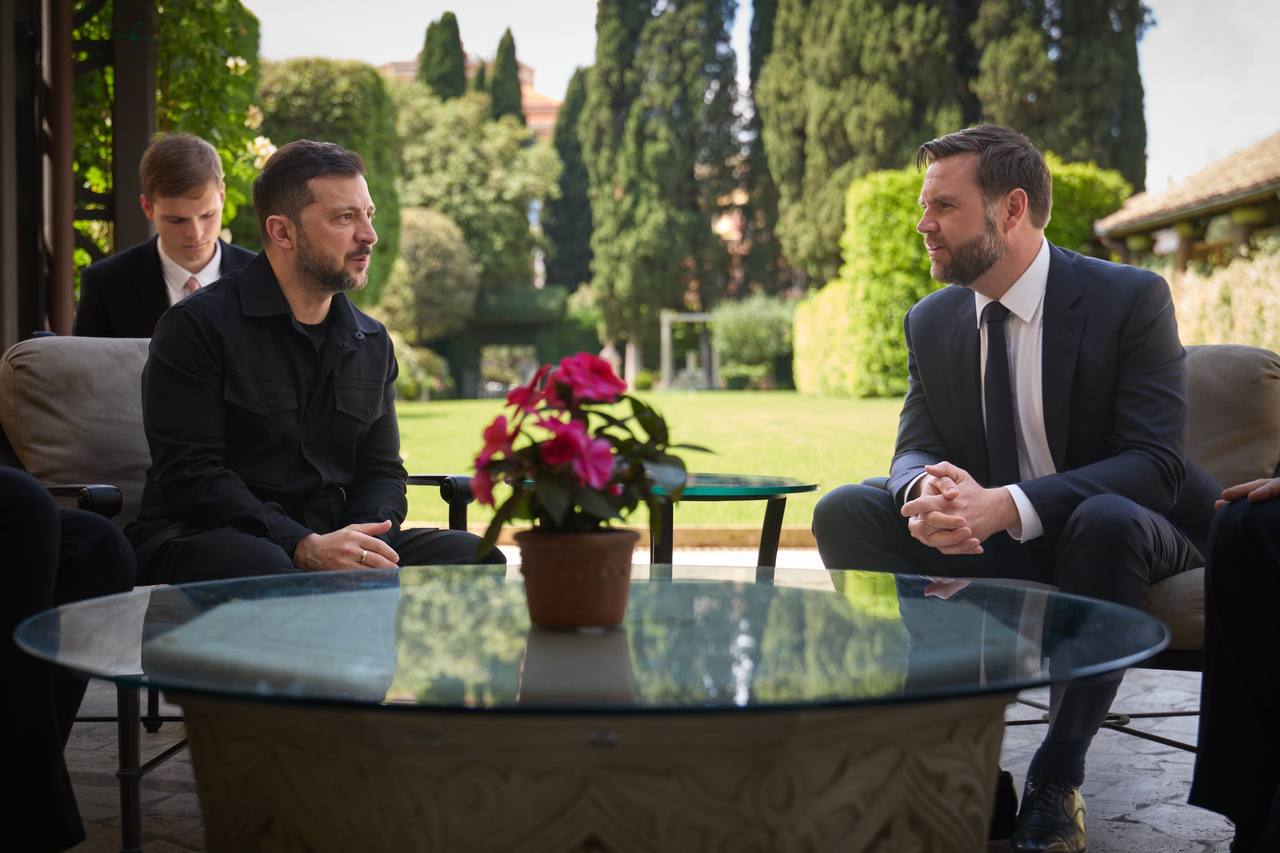
President Volodymyr Zelensky met with U.S. Vice President JD Vance and Secretary of State Marco Rubio, at the Vatican. (President Volodymyr Zelensky / Telegram)
The meeting with Vance marked their first public encounter since their heated Oval Office exchange with Trump on February 28. Zelensky emphasized Ukraine’s readiness for “real diplomacy” while underscoring the importance of maintaining pressure on Russia through sanctions.
“During our talks we discussed negotiations in Istanbul to where the Russians sent a low level delegation of non-decision-makers,” Zelensky wrote on social media. He reiterated Ukraine’s commitment to an unconditional ceasefire while highlighting the upcoming prisoner exchange as the only concrete achievement from recent talks.
At the Vatican, Zelensky presented Pope Leo XIV with an icon painted on a fragment of an artillery shell—”Mother of God with Child” from the war-torn town of Izium. The gift symbolized children “who suffered from the war, who were deliberately kidnapped and deported by Russia and who are very much awaited at home in Ukraine.”
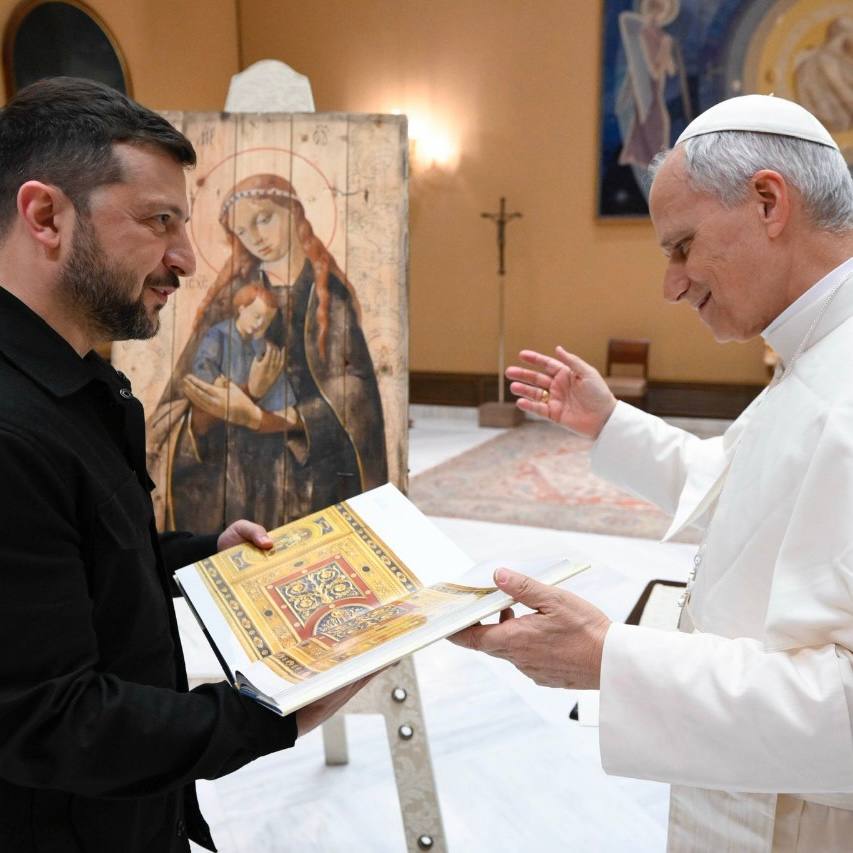
President Volodymyr Zelensky presents Pope Leo XIV with an icon from Ukraine in their first in-person meeting at the Vaticon. (Volodymyr Zelensky / Telegram)
Secretary of State Rubio confirmed that the Vatican could serve as a venue for future peace talks, noting that “both sides would be comfortable” holding negotiations there. Cardinal Pietro Parolin emphasized the Holy See’s readiness to host direct talks, though he acknowledged that Putin’s absence from Istanbul talks was “tragic.”
The Peacekeeping Question: Europe Debates Troop Deployment
German Chancellor Merz sought to dampen speculation about future peacekeeping deployments, stating that Europe was “far from” discussing foreign troop deployment to Ukraine. “There is no reason to talk about [troops] at the moment, we are far from that. We want the weapons to stop, the killing to end,” he said.
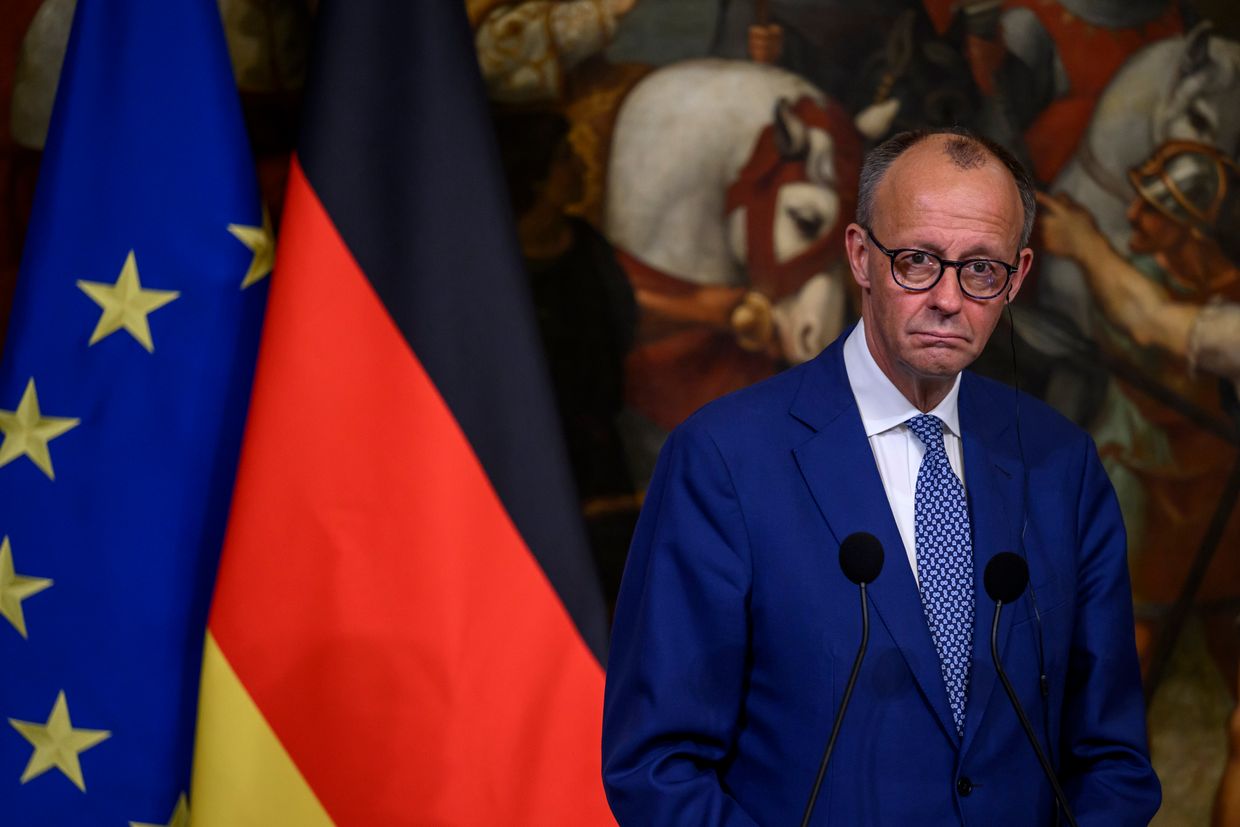
German Chancellor Friedrich Merz holds a joint press conference with Italian Prime Minister Giorgia Meloni (not in picture), in Rome, Italy. (Antonio Masiello/Getty Images)
His comments came amid growing interest in a potential multinational force to monitor any future peace agreement. A “coalition of the willing” led by Britain and France had proposed a “reassurance force” that would monitor ceasefire compliance rather than engage in combat with Russia.
While U.S. President Trump had ruled out American troops, U.S. officials indicated Washington could support such a coalition with intelligence-sharing and logistics. The concept remained theoretical given Russia’s rejection of any international presence on Ukrainian territory.
Kremlin spokesperson Dmitry Peskov had categorically rejected European peacekeepers, arguing that “we cannot allow NATO’s military infrastructure to get that close to our borders.” This position suggested that any future peace agreement would need to address security arrangements without relying on Western military presence.
Looking Ahead: The Moment of Truth Approaches
As May 18 concluded, the stage was set for what could prove a pivotal conversation between Trump and Putin. The day’s events had clarified the stakes: Russia’s record drone attack demonstrated Moscow’s commitment to military pressure, while Putin’s documentary remarks revealed his unwillingness to compromise on fundamental war aims.
European leaders’ coordination efforts showed continued Western unity, even as questions remained about America’s ultimate position. Romania’s election result proved that democratic societies could resist extremist, pro-Russian influences when properly mobilized.
For Ukraine, the day reinforced both the urgency of ending the war and the dangers of accepting peace on Russian terms. Putin’s nuclear brandishing and maximalist demands suggested that any conversation with Trump would test whether American patience had finally shifted toward pressuring Russia rather than Ukraine.
The prisoner exchange agreed in Istanbul remained the only concrete achievement from recent diplomatic efforts—a humanitarian victory that nonetheless highlighted the broader failure to achieve meaningful progress toward peace. As telecommunications lines prepared to carry the Trump-Putin conversation across continents, the fundamental question remained whether words could accomplish what weapons had failed to achieve: changing the trajectory of a war that had already cost hundreds of thousands of lives and shown no signs of natural conclusion.
In many ways, May 18 represented the full spectrum of modern warfare: from technological terror raining from the skies to diplomatic theater played on global stages, from nuclear intimidation to democratic resilience. As Putin prepared to speak with Trump, the world waited to learn whether this conversation would mark another failed attempt at peace or the beginning of meaningful progress toward ending Europe’s deadliest conflict since World War II.
